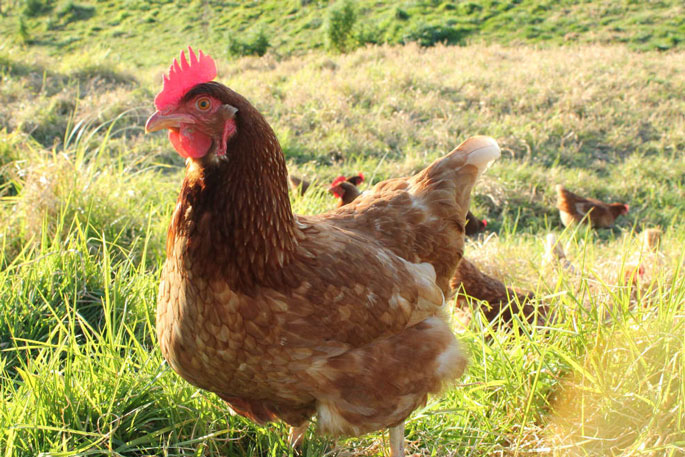The high pathogenic avian influenza - otherwise known as bird flu - has been found on a free range chicken farm in North Otago.
Laying hens foraging outside were thought to have been infected with the H7N6 strain through a low pathogenic virus from wild waterfowl.
So how will this affect Kiwi consumers? And could it spread to our beloved native birds? Here's what you need to know.
Where and when was bird flu discovered in New Zealand?
Speaking to media on Monday, Minister for Biosecurity and Food Safety Andrew Hoggard gave a timeline of the virus's emergence in this country.
A chicken farmer on Hillgrove Egg Farm, belonging to Mainland Poultry, near Moeraki - halfway between Dunedin and Oamaru - noticed birds falling ill on Monday.
He called a local vet, who treated the birds with antibiotics. But as more began to die, the farmer notified the Ministry for Primary Industries on Friday.
Testing teams arrived at the farm on Saturday, and the results came back positive later that day, and confirmed it was the H7N6 strain. The farm was locked down on Sunday, and testing and tracing of movement continues.
On Tuesday, MPI said the birdflu had spread to a second shed on the same farm, meaning 80,000 chickens will have to be killed.
Additionally, all poultry exports are on hold until the country is free of the highly pathogenic bird flu.
We've heard a lot about H5N1. Should we be worried about this other strain?
The H7N6 strain is "low pathogenic" in a lot of wildlife, which means it's there all the time, without causing any issues.
On the other hand, the "high pathogenic" strain found last week causes disease, spreads rapidly, and kills a lot of birds, very suddenly.
How does bird flu spread?
Chickens - especially on free range farms - often come into contact with wild birds, and the disease is passed between them, and then with other chickens in the shed through shared feed and water.
It can also be spread by people and equipment, which is why MPI locked down the one shed, and immediately started contact tracing and testing at the farm.
"These viruses can jump and spill over between animals very rapidly," virologist Professor Jemma Geoghegan told Checkpoint.
Could bird flu spread to other farms?
The main risk around this discovery is that it will affect New Zealand's poultry industry. That's why MPI was acting quickly to "depopulate" the chickens in the affected shed, says director-general Ray Smith, and trace any movements from that farm in the past couple of weeks.
MPI is investigating six other farms in total, which had connections to the infected farm. There are potential risks at two specific farms, and another four have low- to medium-level risk of infection.
MPI is doing testing there and trying to work out what and who had moved between farms. As at Monday, there were no signs in any other poultry farms of sickness or reduced production.
MPI is "very confident" the virus will not spread, Smith said. In the last four years, two other diseases common in poultry - IBDV and salmonella enteritis - have cropped up, but they'd eradicated both swiftly by tracing the disease, locking down the farms and killing the affected fowl.
It's helpful the affected farm is "very isolated" from neighbouring properties. "We're in a much better place than Australia was in stopping it and eradicating it."
Are our native birds safe?
Although the mild version of the virus is everywhere in the wild, there is no evidence from overseas of the severe form moving from poultry back to wildlife.
The Department of Conservation chief Penny Nelson said DOC was already working with MPI to prepare for H5N1. There had also been some vaccination trials of wild birds, but this is tricky as they needed to be easy to capture and check, she said.
Should I still be eating New Zealand-raised eggs and chicken?
Yes, our poultry and eggs are safe. Just make sure you follow the usual rules around cooking and eating eggs and chicken.
"Avian influenza is very susceptible to heat, so cook it in the normal manner," Hoggard said.
"We're constantly telling people don't eat raw chicken, and this reinforces that message."
People overseas have been known to have H7N6, Geoghegan says, but the virus is designed to spread between birds, so it's bad at crossing over to humans.
Hoggard went further in today's media conference, saying there's been no evidence of any cases of people contracting the disease and MPI is "fairly confident" there is minimal risk to Kiwis.
Will there be an egg shortage?
Because the virus has appeared only in one shed, on one farm in North Otago, there'll be no impact on egg supply, Hoggard said.
"I'd just stress to people, we don't need to go out and stockpile eggs."
What happens to the infected chickens?
There are 80,000 chickens in the two sheds where the virus was found, and teams will start culling them on Tuesday.
Poultry farmers are used to depopulating and repopulating their birds, Smith said.
The birds will be herded into enclosed containers and gassed with carbon dioxide.
The farmer was "a bit beaten up", Hoggard said, but the industry is well prepared for an outbreak, and the whole process of killing the birds, cleaning the sheds, further testing and repopulating will take about four to six weeks.
The virus has an incubation period of 14 to 21 days and testing will continue until the farm has the all-clear.
Because the ministry shut down the farm using powers under the Biosecurity Act, the farmer will be compensated for any costs incurred.



0 comments
Leave a Comment
You must be logged in to make a comment.